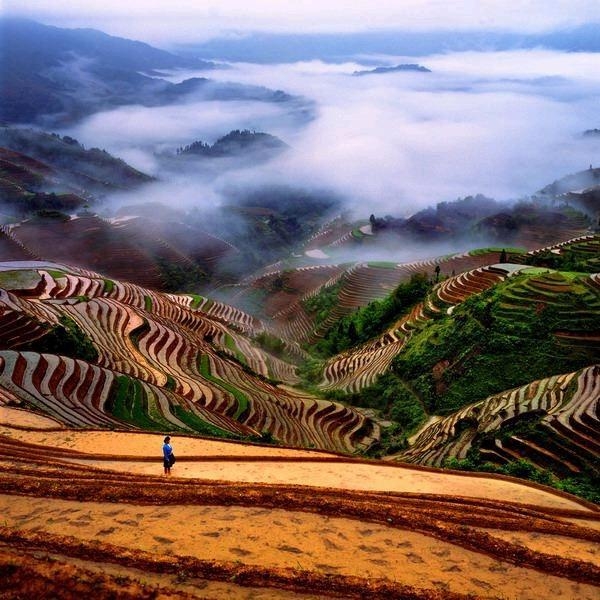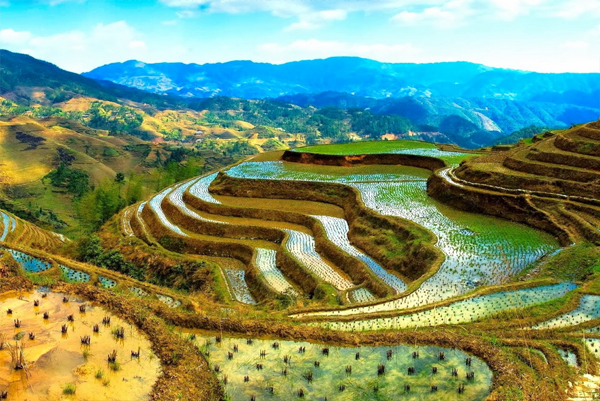The Banaue Rice Terraces were created by human hands between 2,000 and 6,000 years ago in the Ifugao region. With its spectacular natural scenery, especially during the ripe rice season and the flooding season, this place is revered by backpackers as the "8th Natural Wonder" of the world.

The charming landscape of Banaua captivates many backpackers. Photo: Papalengtraveladventure
The form of farming on terraced fields along the mountainside is not too strange to the people of the wet rice civilization in Southeast Asia. But for Western tourists, seeing the gently sloping fields of golden yellow flowers or shimmering water is truly an unforgettable experience in life. They call Banaue a giant hanging garden on the mountain top.
Banaue is located at an altitude of 1,500 meters above sea level and covers an area of 10,360 square kilometers. The ancestors of the indigenous people of the Cordillera mountains used a unique and efficient irrigation system to irrigate their crops with water drawn from the nearby rainforests.

The beautiful scenery of terraced fields is an endless source of inspiration for photographers.
Not only providing food for the people, the rice terraces in Banaue also contain many traditional cultural values of the local people. All social activities, farming, and festivals are associated with every square meter of these rice terraces. Whenever someone comes to buy a field, the Ifugao people organize a special party with the characteristics of their people to pray for the field to produce a lot of crops.
However, since 2001, facing the risks of external impacts, UNESCO has included the Banaue Rice Terraces in the list of heritages in danger, due to the blending of different cultures, economic and political factors that have greatly affected the core traditional values in Ifugao.

This place is also an endless source of inspiration for photographers from all over the world. In recent years, Banaue tourism has attracted more and more attention, especially after beautiful photos of the ripe rice season or the flooding season were posted by photographers on social networks.
Unlike the plains with fields stretching as far as the eye can see, terraced fields are stacked and softly curving along the high mountain slopes like steps rising above the green. During the ripe rice season, the entire space is golden yellow as far as the eye can see, creating a breathtakingly beautiful scene like a painting. During the flood season, under the sunlight, each step is covered with sparkling water, reflecting the silhouettes of people and the clouds, making the beauty of everyday life even more beautiful.
Vehicle
From Manila, visitors can buy a ticket for a high-quality long-distance bus to Banaue, which will take about 9 hours for a distance of nearly 400km. These buses are equipped with air conditioning and cost about 400-550 pesos (from 600,000 VND to more than 800,000 VND). There are many stops along the way such as in the provinces of Bulacan, Nueva Ecija, Nueva Vizcaya, so if you do not depart from Manila, you can completely get on from any stop. The list of these stops can be obtained from the headquarters of the bus companies or on their official websites.
Dangwa Transit operates daily trips to Banaue. Its stations are located along Dimasalang Road, Sampaloc, Manila and Aurora Boulevard, Cubao, Quezon City (tel: +63 731-2879 and 410-1991)
Also running the Banaue route, visitors have another option: Auto Bus (tel: +63 735-8098) with a stop at España Blvd corner G. Tolentino, Manila. The bus departs at 10am daily and arrives around 7pm. From Bagio City, there are also buses that go directly to Banaue.
Place of residence
Eating and sleeping in Banaue is not too big of a problem. You can find hostels with different prices in town such as Banaue View Inn, People's Lodge, Banaue Hotel... You can also choose to stay with locals in the form of homestay to save costs as well as have more unique experiences.
Restaurants in Banaue are not very rich. Visitors can visit: Sanafe Lodge & Restaurant, (tel. +63 74 386 4085 +63 74 386 4085) open from 6am to 9pm. Or Ilob Village Inn, (Poblacion, Banaue, about 1km from the bus station) with many traditional Ifugao dishes, you can also request to watch cultural performances right at the restaurant.
Ideal timing
You should visit Banaue around June - harvest season when the rice is golden all over the hillsides. Avoid the rainy season because it will prevent you from getting beautiful photos. The best time to visit Banaue is from December to June.


































